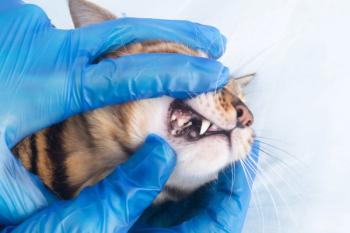
Epidemiology of feline uroliths and urethral plugs
In 1981, calcium oxalate was detected in only 2 percent of feline uroliths submitted to the Minnesota Urolith Center, whereas struvite was detected in 78 percent. However, beginning in the mid-1980s, a dramatic increase in the frequency of calcium oxalate uroliths occurred in association with a decrease in the frequency of struvite uroliths (Figure 1) .
In 1981, calcium oxalate was detected in only 2 percent of feline uroliths submitted to the Minnesota Urolith Center, whereas struvite was detected in 78 percent. However, beginning in the mid-1980s, a dramatic increase in the frequency of calcium oxalate uroliths occurred in association with a decrease in the frequency of struvite uroliths (Figure 1) .
Carl A. Osborne
From 1994 to 2002, approximately 55 percent of the feline uroliths submitted to the center were composed of calcium oxalate, while only 33 percent were struvite (Figure 1). During this period, the decline in appearance of naturally occurring struvite uroliths associated with a reciprocal increase in calcium oxalate uroliths may have been associated with:
1) Widespread use of a calculolytic diet to dissolve struvite uroliths,
2) Modification of maintenance and prevention diets to minimize struvite crystalluria (some dietary risk factors that decrease the risk of struvite uroliths increase the risk of calcium oxalate uroliths) and
3) Inconsistent follow-up evaluation of efficacy of dietary management proto-cols by urinalysis and radiography
Figure 1
In 2003, the frequency of calcium oxalate uroliths declined to 47 percent, while the frequency of struvite uroliths increased to 42 percent. During 2004, the number of struvite uroliths (44.9 percent) submitted to the urolith center nudged past those containing calcium oxalate (44.3 percent). In 2005, the number of struvite uroliths (48.1 percent) surpassed those containing calcium oxalate (40.6 percent) in frequency of occurrence (Figure 1).
Figure 2
Of 10,093 feline uroliths submitted to the center in 2006, 5,001 (50 percent) were struvite, and 3,914 (39 percent) were calcium oxalate. In 2007, of 11,174 uroliths submitted, 5,432 (49 percent) were struvite and 4,553 (41 percent) were calcium oxalate (Figure 2 and Table 1). The progressive decrease in occurrence of naturally occurring calcium oxalate uroliths during the past five years may be associated with:
1) Reformulation of adult maintenance diets to minimize risk factors for calcium oxalate crystalluria,
2) Improvements in formulation of therapeutic diets designed to reduce risk factors for calcium oxalate uroliths and
3) Increased use of therapeutic diets designed to reduce risk factors for calcium oxalate uroliths.
The increase in appearance of naturally occurring struvite uroliths during the past five years may be associated with the reciprocal relationship between some dietary risk factors for calcium oxalate and struvite uroliths. For example, diets that reduce urine acidity and provide adequate quantities of magnesium reduce the risk of calcium oxalate urolith formation, but increase the risk of struvite (magnesium ammonium phosphate) urolith formation.
Photo 1: Three different types of struvite that may occur in cats: A and B, sterile urocystoliths; C, infection-induced urocystolith; D, matrix-struvite urethral plug.
The sustained increase in occurrence of struvite uroliths from 2003 to 2007 may be associated with decreased use of diets designed to dissolve sterile struvite uroliths as a consequence of the significant increase in occurrence of calcium oxalate uroliths in the 1980s and 1990s. However, it is likely that most of the 5,432 sterile struvite uroliths obtained from cats and submitted to the urolith center in 2007 could have been readily dissolved in two to four weeks by feeding a diet designed to promote formation of urine that is undersaturated with struvite.
Photo 2: Low-power transmission photomicrograph of matrix-struvite urethral plug depicting struvite crystals (clear spaces) surrounded by matrix.
Epidemiology of feline urethral plugs
Of 506 urethral plugs submitted to the urolith center by veterinarians in 2007, the mineral composition of approximately 92 percent was primarily struvite, with only 1 percent composed of calcium oxalate (Figure 3 and Table 1). Since 1981, struvite has consistently been the most common mineral in feline urethral plugs (Figure 4), and the prevalence of calcium oxalate in urethral plugs always has been infrequent.
Figure 3
The explanation as to why there have been significant shifts in the prevalence of calcium oxalate and struvite in feline uroliths during the past 25 years, while the prevalence of struvite and calcium oxalate in feline urethral plugs has not significantly changed, is not obvious to us.
Figure 4
Whatever the reason(s), the high prevalence of struvite in urethral plugs is of clinical significance in terms of the design of dietary strategies to prevent their formation.
Table 1
Dr. Osborne, a diplomate of the American College of Veterinary Internal Medicine, is professor of medicine in the Department of Small Animal Clinical Sciences, College of Veterinary Medicine, University of Minnesota.
Newsletter
From exam room tips to practice management insights, get trusted veterinary news delivered straight to your inbox—subscribe to dvm360.



